After visiting Italy on three separate occasions with my dog, Italy is hands-down one of the most dog-friendly destinations in Europe.
While the German-speaking countries have a reputation for being dog-friendly (and certainly are), in Italy there’s even more places that you can visit with a dog, including rather relaxed rules when it comes to dogs, that I haven’t encountered in other destinations.
Read on to find out what it’s like travelling in Italy with a dog…
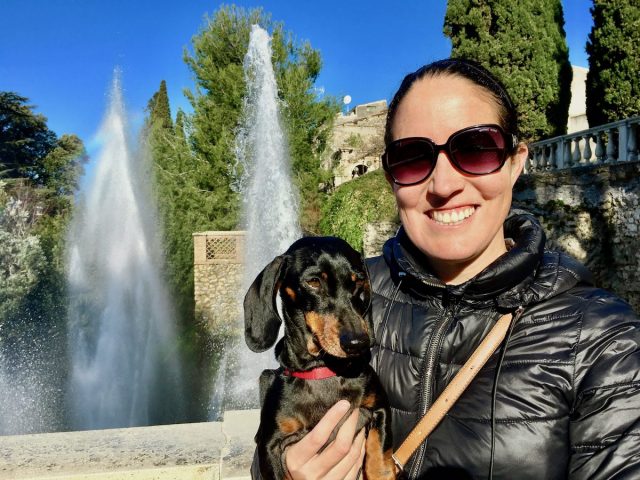
Travelling to Italy with a Dog
The same rules apply for taking a dog to Italy as for other EU countries. To find out the requirements if you are travelling from outside the EU, click here. If you are already in the EU, a microchip, pet passport and valid rabies vaccine is required. Find out more about how to travel to Italy with a dog.
Note that when you leave Italy with a dog, if you are flying to a non-EU country, an additional step is required.
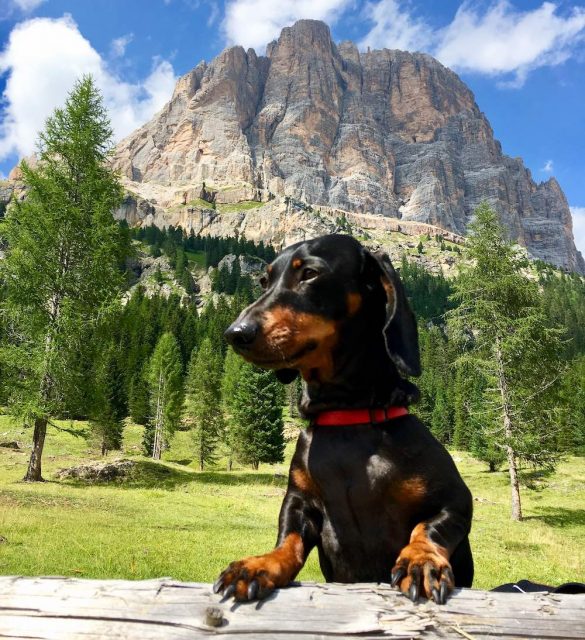
Exporting a Dog from Italy
When cats and dogs fly out of Italy to a non-EU country, the Italian government requires that your pet has a Pet Export Certificate. This includes pets flying to the USA. I’ve heard varying reports though whether this applies to pets simply holidaying in Italy – it’s best to check with your airline or get one just in case.
You firstly need to obtain a certificate of good health from a local veterinarian. Then within 48 hours visit the local ASL (Azienda Sanitaria Locale), who will check your pet’s health and rabies certificates and issue an export certificate, for a small fee. For full details, see this US embassy website.
The US website states the export certificate is valid for only 6 days, but I’ve also heard it’s valid for 30 days. The US website also states that your pet must have been vaccinated against rabies in the last 11 months, but normally the 3-year rabies vaccination is recognised in the EU.
I don’t have personal experience at obtaining this certificate, as I have not flown out of the EU from Italy. This requirement does not apply when flying out of other countries, such as France, something to keep in mind if you’re considering where to fly out of Europe.
Dining Out in Italy with a Dog
You’ll have no trouble finding dog-friendly restaurants in Italy to dine at with your dog. While there are some places that have a sign at the door stating no dogs are allowed, usually bakeries or small bars, most restaurants and cafes will allow dogs inside. Although always first check with the waiter.

Alternatively, even when we visited Italy in January and February, it was still sometimes warm enough on a sunny day to sit at the outside seats. If there’s outside seating and the weather is pleasant, the owners will usually appreciate you choosing that option.
Another alternative is to head to one of the indoor market halls in Italy, such as the Mercato Centrales in Rome and Florence. Both of these markets welcome dogs, although reserve the right to issue muzzles for large dogs. We visited both these markets with our small dog with no issues.
These market halls, similar to food courts, contain multiple restaurants, great for if you want to sample a variety of food, alongside one or two bars and long tables and benches. We even spotted an elderly man feeding his dog at his feet some very expensive steak in Florence! There are also two more locations in Milan and Turin.
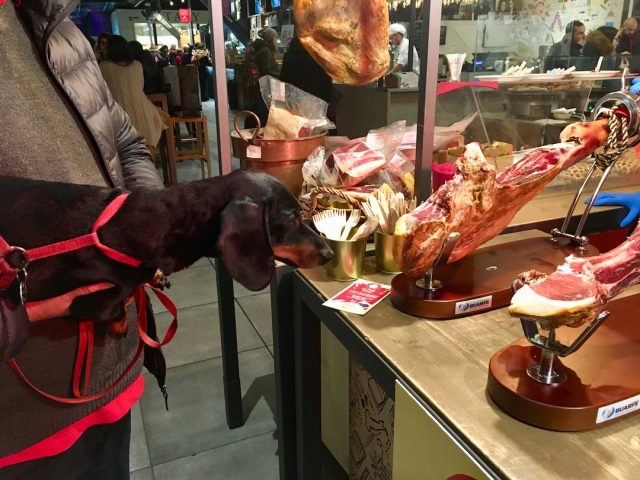
Shopping in Italy with a Dog
We experienced no issues bringing along our dog when shopping in Italy, at least in clothing and gift stores. Dogs are a common sight inside many shops and malls.
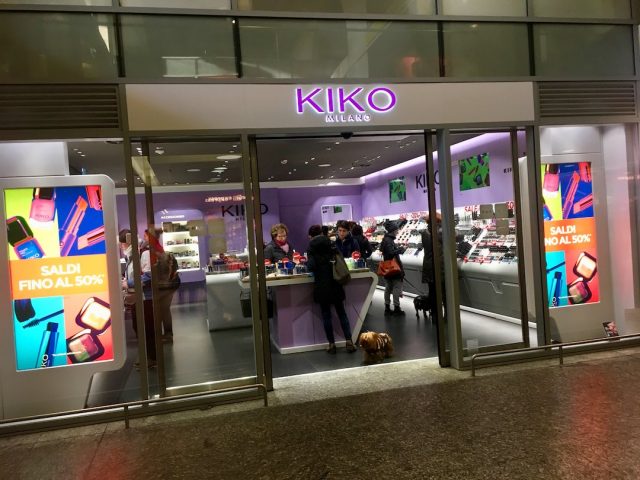
Additionally, unlike in other parts of Europe, even some grocery stores in Italy allowed dogs inside. We spotted this at our local grocery store in Turin. Although we were then told off when we carried our pup – the rules for this store was that dogs had to be on the floor!
We also purchased some fancy Italian groceries at the Eataly store in Genoa with our dog at our side.
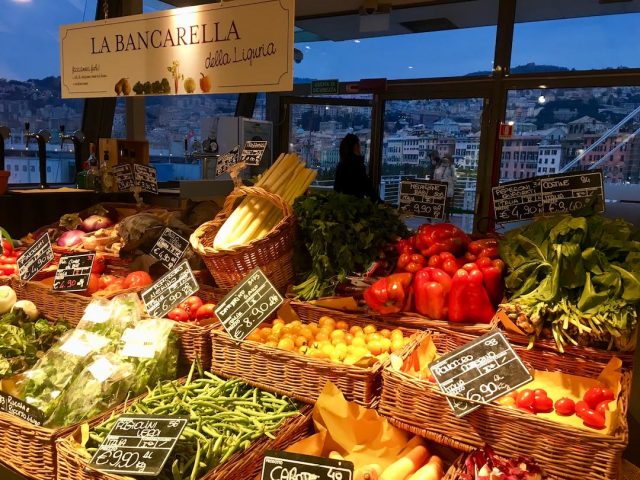
Taking a Dog on Public Transport in Italy
Dogs are welcome on most public transport in Italy. And even if there are rules, just like many rules in Italy, they’re not always enforced.
For instance, generally there’s a rule that dogs on public transport need to wear a muzzle. However, it’s usually enough to just carry one and put it on if requested, as this rule is not frequently enforced, especially for small dogs. (We were never asked for our Miniature Dachshund.)
It’s also sometimes required to have your dog’s paperwork with you (the pet passport for non-locals), although we never had this requested.
Rules for Dogs on Trenitalia Trains
We frequently travelled around Italy on trains operated by Trenitalia, the main train company. Tickets on regular regional trains are cheap compared to elsewhere in Western Europe and don’t need to be booked in advance, although book the tickets for the more expensive high-speed services in advance.

Small dogs in a carrier no larger than 70 x 30 x 50 cm are permitted to travel for free, in all classes of trains. Although we also took our small dog multiple times on trains without his carrier and without a ticket, especially on day trips, and none of the ticket inspectors said anything.
Larger dogs need to be on a leash and muzzled, and are not allowed on certain carriages or trains (not in Executive class, Premium class or the Quiet Zone on high-speed trains, not on regional trains between 7am to 9am on weekdays). Larger dogs are also required to have a special dog ticket.
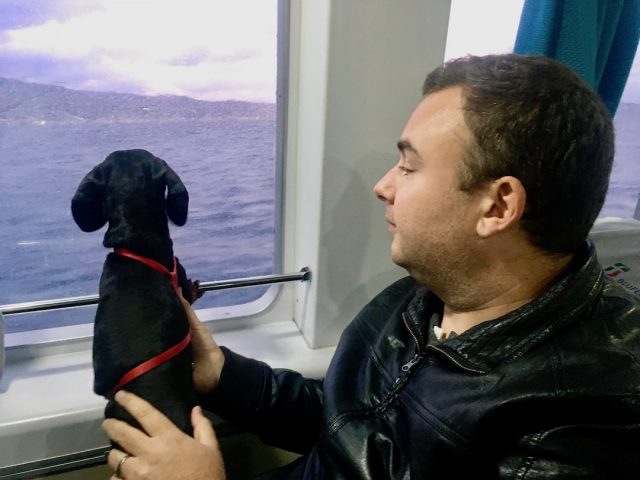
Rules for Dogs on Local Transport
In Rome, small and medium-sized dogs are allowed to travel on the metro, buses and trams. They need to wear a leash and a muzzle (or other small animals can travel in a carrier bag), and have an ordinary fare ticket (unless a guide dog, although I don’t think we bought a ticket for our dog). Additionally, dogs are only allowed on the first and last carriage of the metro and regional trains, plus there is a maximum of two dogs on a bus.
The rules for dogs on public transport in Milan are similar, as listed in their regulations for metro and buses and trams (Italian only). Only small and medium-sized dogs are allowed. They need to wear a leash and muzzle, unless they are in a carrier, with sides up to 50cm in size.
Only two carriers are permitted per passenger, otherwise one dog per carriage on the metro. Additionally, dogs not in a carrier are not permitted between 7.30 and 9.30 and 17.30 and 20.30.
If you are heading to Venice, dogs are definitely allowed on the vaporettos, the water boats that criss-cross Venice, with no ticket required. Dogs are expected to be on a leash and muzzled, although generally a muzzle isn’t enforced, at least for smaller dogs. Just be warned that some of the vaporettos along the Grand Canal can get very crowded, so are best avoided with a dog!
Dog-Friendly Accommodation in Italy
We had no troubles finding dog-friendly accommodation in Italy, whether it was Airbnbs next to Lake Como or around Sicily, a centrally located hotel in Milan or an agroturismo in Tuscany.
When comparing how dog-friendly the hotels in different European cities were, both Florence and Rome were in the middle of the pack, with 49% and 31% of hotels allowing dogs, respectively. However, there are a huge number of hotels and guesthouses in most Italian cities, so the numbers of dog-friendly establishments are still huge.
Expect hotels to be more welcoming towards small dogs, and that that there is usually a small fee charged.
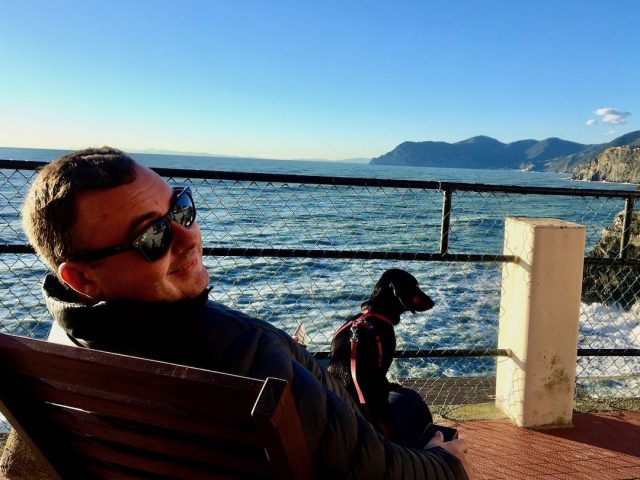
If you are having trouble locating an affordable dog-friendly hotel, or prefer staying in your own apartment, then turn to Airbnb and other holiday home rental platforms.
City centre apartments in Italy can be noisy when facing the street, so be aware if your dog is reactive to noise like ours. But we found plenty of offerings, plus many agroturismo establishments are listed on these websites these days.
Dog-Friendly Parks in Italy
While travelling in Italy with our dog we didn’t stumble across many dog parks. But that’s not because dog parks (known as “area cani” in Italian) don’t exist, simply that they’re usually outside of the city centre, so you need to search for them (just enter “dog park” on Google) and then purposely visit them.
One dog park we did stumble across was in Naples, that city of unexpected discoveries. There’s a convenient dog park just outside the Monastery of Santa Chiara, near the Piazza del Gesù Nuovo. We also noticed that some of the parks in Milan had fenced dog runs.
And I regret not heading to the beautiful Villa Borghese in Rome, somewhere I had visited on previous visits without my dog, as I later discovered it’s home to a superb dog park (called the “Area Cani Villa Borghese” on Google Maps or the “Bioparco” on Apple Maps).
When it comes to regular parks in Italy, the Italians aren’t as strict as the French, and dogs sometimes might be allowed, but not always. One example of a garden that unfortunately doesn’t allow dogs is the Boboli Gardens in Florence.
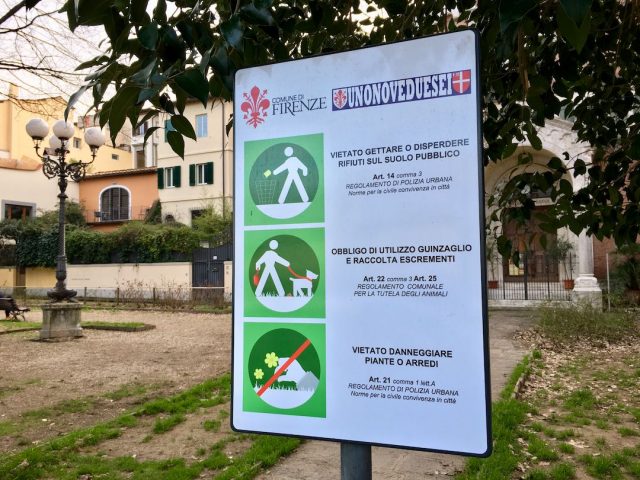
Dog-Friendly Sightseeing in Italy
If you’re travelling in Italy with a dog, you’ll be delighted to discover that there’s a huge variety of dog-friendly sightseeing options in Italy.
For starters, most of Italy’s impressive archaeological remains are not off limit to dogs, something that we found was the case in Greece (although the rules have recently relaxed). Dogs are permitted in many sites ranging from Ostia Antica to Pompeii.
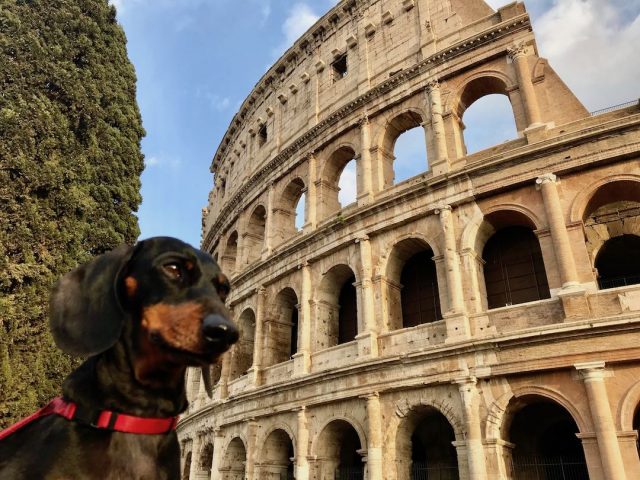
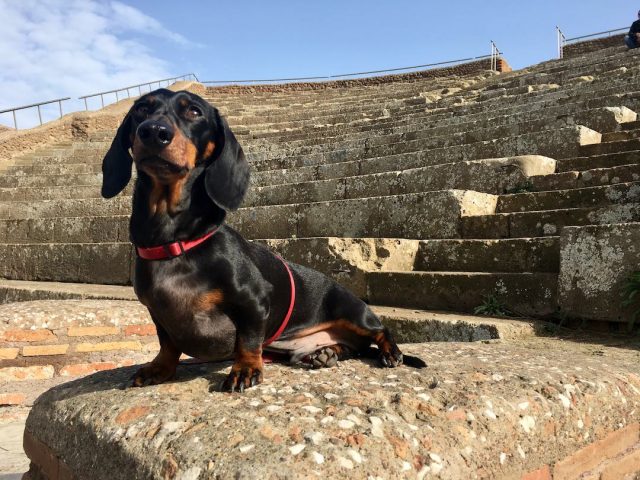
A dog is also the perfect companion to explore the many historic cities and towns in Italy. Wander through the laneways of Venice (just head to the backstreets to avoid the crowds), the gorgeous hilltop towns of Tuscany, or World Heritage-listed Matera or Alberobello in the south.
Previously, small dogs in carrier bags were even allowed inside the former Royal Palace at Turin, although this is unfortunately no longer the case.
Don’t also forget the beautiful natural scenery in Italy, such as hiking (or taking cable cars) in the Dolomites.
Often details on whether dogs are allowed are only found on the Italian language pages. I often googled the name of the attraction and “cane” (dog) or “cani” (dogs), then used Google Translate, to confirm the pet rules in advance.
For my top recommendations on sightseeing in Italy with a dog, check out these dog-friendly options.
1. Explore Ancient Archaeological Site
Italy is home to many popular archaeological sites, ranging from Roman to Greek to Etruscan. And luckily, most of them allow dogs on a leash to join you.
There are some exceptions. For starters, in Rome, pet dogs are not allowed inside the Colosseum. Up until recently, pet dogs were also not allowed at Palatine Hill and the Forum, but small dogs in a carrier are now permitted – see my Rome guide for the full details.
Dogs are also not allowed at some smaller sites such as the Villa Romana del Casale and Taormina Amphitheatre, both in Sicily.
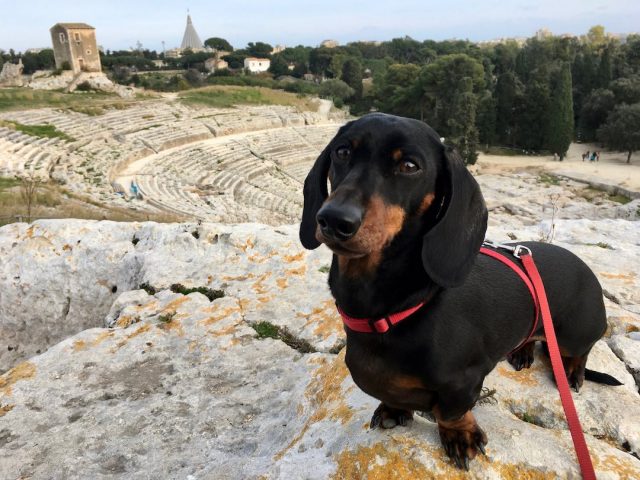
Here are some of the other archaeological sites we visited (or could have visited) with our dog:
- Pompeii: The most famous archaeological site in Italy, small dogs are allowed as long as they remain on a leash and are carried inside buildings (or one of you stays outside). Signs onsite state that dogs should weight no more than 10kg and be no taller than 40cm.
- Ostia Antica: If visiting Rome with your dog, don’t miss visiting the harbour city of ancient Rome, located just 45 minutes south-west via metro and local train
- Villa Adriana: The emperor Hadrian’s amazing palace complex is located near Tivoli, about 1 hour east of central Rome, via a combination of train and local bus, or by road
- Paestum: A couple of hours south of Naples, home to some of the most magnificent Greek temples anywhere in Europe
- Neapolis Park, Syracuse: On the island of Sicily, home to both a Roman amphitheatre and a Greek theatre
- Agrigento: Also on Sicily, a superb complex of Greek temples and ruins
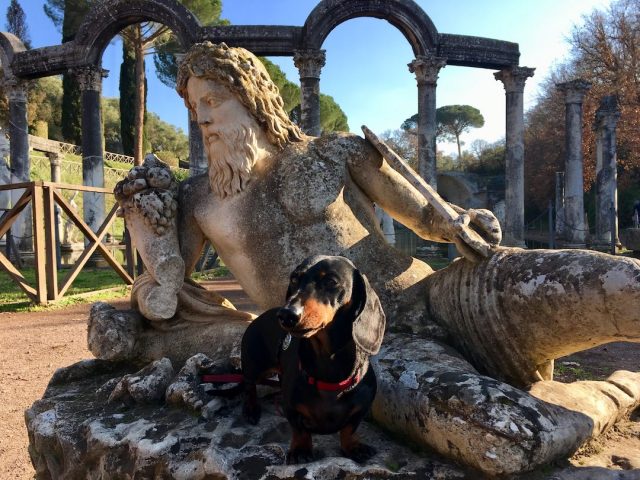
2. Visit the Beautiful Villa d’Este
Some of the gardens in Italy dating back to the Renaissance period are amongst the most beautiful anywhere in the world. And one of the most magnificent gardens of all is located at the Villa d’Este, in the small town of Tivoli, just to the east of Rome (under 1 hour via train). Here the gardens take advantage of the steep hillside to feature countless fountains and cascades.
Dogs are not only allowed inside the gardens, as long as they are kept on a leash (and wearing a muzzle for large dogs), but they’re even allowed inside the old Villa d’Este. The walls of the villa are covered with frescoes, many related to the themes of the gardens, although the highlight is undoubtedly the gardens themselves.
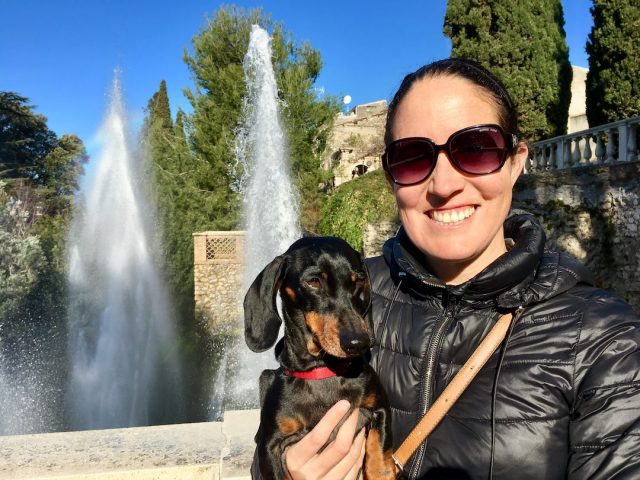
3. Get Lost in Venice
Despite the crowds and expensive accommodation, Venice is still an irresistible destination in Italy. And best of all, if you’re mainly sticking to wandering the laneways and canals, soaking up its charm, your dog will make the perfect travel companion. Your biggest possible issue? Being mistaken as a local and having people speak to you in Italian!

While we didn’t take Schnitzel on a gondola ride, I’m sure dogs would be welcome, as long as you can afford the hiring fee (probably without sharing with other tourists).
Dogs are definitely allowed on the vaporettos, the water boats that criss-cross Venice, no extra ticket required. Dogs are expected to be on a leash and muzzled, although generally a muzzle isn’t enforced, at least for smaller dogs. Just be warned that the boats going up the Grand Canal can get very crowded in the late afternoon, so are best avoided.
If you’re staying more than a single day in Venice, consider heading out to the island of Burano. This pretty island is best known for its colourful houses, as well as traditional lace work.
Ideally buy a 24 hour or longer pass for the vaporetto. (The 24 hour pass costs €25 as of 2024, with unlimited trips, while two single tickets costs €19). Your dog will appreciate a break from the crowds, plus the grassed areas!
Read more about visiting Venice with your dog
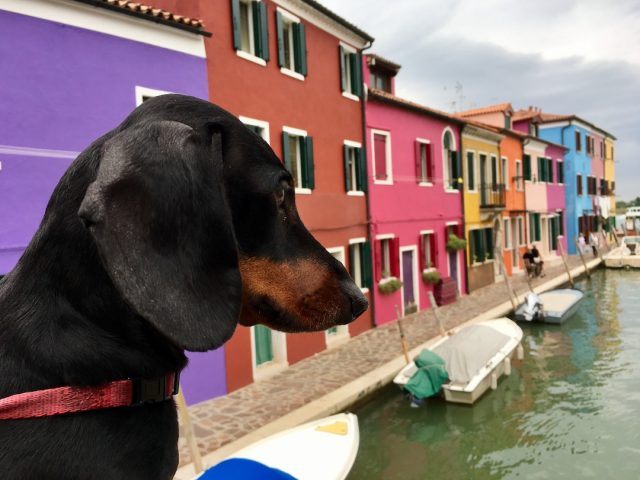
4. Walk the Cinque Terre
The five pretty villages of Cinque Terre and the hiking trails that connect them are very popular, especially during the summer months. So much so that there has been talk about limiting the number of visitors, although this hasn’t yet gone ahead.
However, visiting in during the winter is a different story, and the ideal time to visit Cinque Terre with your dog.
It was a rainy, stormy day when we arrived by train at Manarola in mid-January, and barely any tourists were around. This also meant many of the tourists shops and most of the restaurants were closed. (Luckily our Airbnb host was quick to point out which restaurants in the village were still open.)
But the next day dawned bright and sunny, and it was perfect for exploring the coastline with our dog.
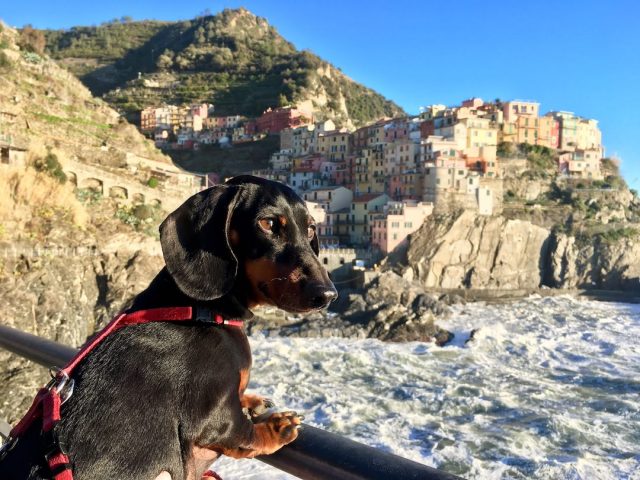
As well as keeping visitor numbers down, the trails between the villages are a lot more pleasant to walk during the cooler days of winter, or cooler periods of spring or fall. We didn’t do much hiking, as Schnitzel was still recovering from his IVDD and required carrying, but with the steep ascents and rough track underfoot, it was tough enough without the summer heat.
If you’re looking for gentler walks, take the 1km Via Dell’Amore walk between Riomaggiore to Manarola (which was closed due to a landslide during our visit, but has since reopened) or stroll along the paved paths of Monterosso.
Read more tips for visiting Cinque Terre
5. Discover the Hill-Top Towns of Tuscany
Not far away from the Cinque Terre, and best accessed from the city of Florence, the hill-top towns of Tuscany have been captivating visitors for centuries. When we visited during winter time, many of the shops and restaurants were closed, the usually tourist-packed streets quiet. But especially when the sun came out, there was no mistaking the beauty of the landscape.

The best way to experience these towns is to just wander through their streets. Siena in particular has a beautiful cathedral, but as expected no dogs are allowed inside.
Many accommodation options in Tuscany allow dogs. My tip: rather than staying inside one of the towns, it may be better to find a resort or farm-stay out in the countryside, where your dog will have plenty of grass for part of the day.
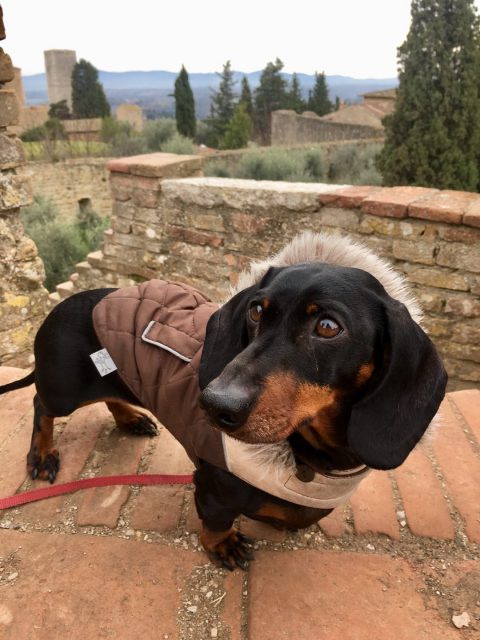
6. Chill in a Villa at Lake Como
If you’re looking for somewhere relaxing to spend a few days in Italy during the summer, head north to Lake Como and book a dog-friendly villa. Okay, you will have to brave its narrow roads first before you get to relax, but then you can enjoy beautiful vistas like the one pictured.
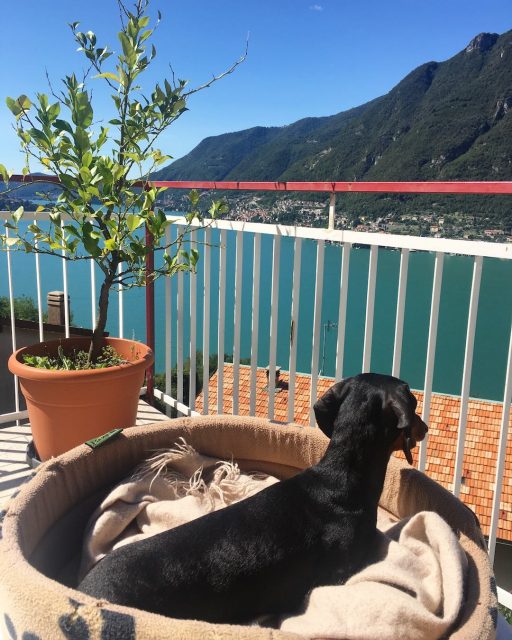
Try and find somewhere close to a beach if the weather is warm, or just hang out and soak up the scenery. If you want to venture out for the day, visit some of the gorgeous villas and gardens around the lake (many that allow dogs in the gardens), or stop by beautiful Bellagio, at the junction in the lake.

Want to check out the interior of a listed villa? At nearby Lake Lugano, Villa Fogazzaro Roi allows small dogs to be carried in your arms or in a carrier during the one-hour long guided tours, for no additional charge.
7. Explore the Trulli in Alberobello
The trulli are the unique stone huts with cone-shapped roofs found in Apulia, southern Italy. The best place to check out these traditional dwellings is in the UNESCO World Heritage listed town of Alberobello.
While many trulli are these days tourist shops, restaurants and B&Bs, there are still plenty that are home to local residents, more so in the Aja Piccola area than the more commercialised Monti quarter.
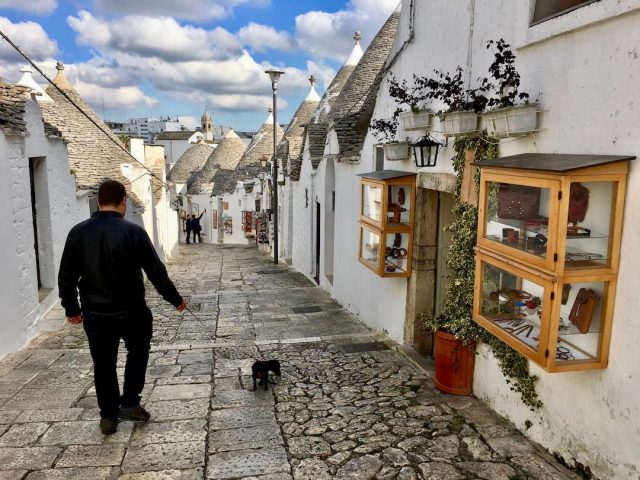
Many of the shop owners welcome visitors to come inside and check out the dwellings (plus hopefully browse their wares), and our dog Schnitzel was always allowed to accompany us. We also visited one home that was open to visitors, where Schnitzel was also welcome, though we had to keep him away from the very comfortable cat!
8. Or Explore the Sassi in Matera
Not far away from Alberobello is the equally charming small city of Matera. Here the traditional homes are also made of stone, but cut out of the hillside, with the name sassi. One of the best things to do here is simply wander along the streets and hillsides, with your dog at your side, feeling like you’re in a place far removed from the modern world.

We also visited a local museum highlighting the traditional lifestyle of the local people, with plenty of displays of tools and photographs, plus one of the rock-hewn churches. In both, Schnitzel was welcome to join us, though we did carry him.
9. Get Lost in the Alleyways of Naples
Naples is one of the most vibrant and lively cities in Italy, especially on the laneways of its historic centre. It may look daunting and it’s best to stick to the local transport rather than drive, but once you’ve entered the district it will likely charm you just like it charmed me.
Here there’s no need to sit down at a restaurant to dine, with some of the best food available straight on the street. From pizzas to arancini to the lobster-like sfogliatelle and baba au Rhum, do like the locals do and buy what grabs your fancy and eat while strolling along.
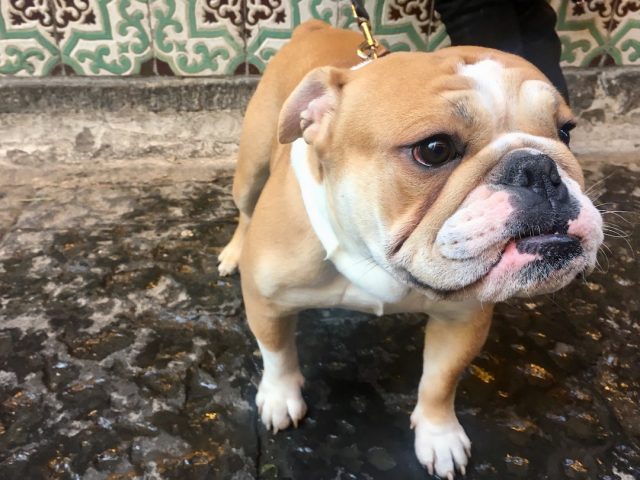
Naturally, there’s countless dogs out with their owners (although keep a watch for unpleasant surprises underfoot). If you’re wanting a break, stop by the Santa Chiara Monastery complex with its small off-leash dog yard, for a play with the local dogs.
10. A Day at the Beach
While many Italian beaches are off-limits to dogs, at least during the summer months, there are also some great dog-friendly options. Consider heading to Lignano Sabbiadoro in northeastern Italy, home to a Doggy Beach.
Operating from May to September, from 9am to sunset, your dog is welcome to join you in this fully enclosed beach, with no restrictions on the number of dogs or time in the water. Note that dogs need to stay leashed while not in the water and proof of vaccines is required.
Access is free to the beach, but there are many rental options, including VIP set-ups that are fully enclosed with a dog bed provided (and no need for a leash inside). There are also showers for dogs, an off-leash agility area and a veterinary service.
11. Dine on a Feast of Italian Food
If you’re wanting to dine out in Italy, you’ll also find that most restaurants allow dogs inside. We only spotted a few “no dogs allowed” signs on the door of restaurants, most often small bars or bakeries. However, always check when entering, and if your dog is large or not the best behaved, there’s plenty of outdoor seats at many restaurants.
Another option to consider are the Mercato Centrales in Rome, Florence, Milan and Turin. These large market halls are like food-courts, with multiple restaurants contained inside, alongside bars and casual seating. Prices aren’t cheaper than in local restaurants, but there’s plenty of variety and dogs are allowed.
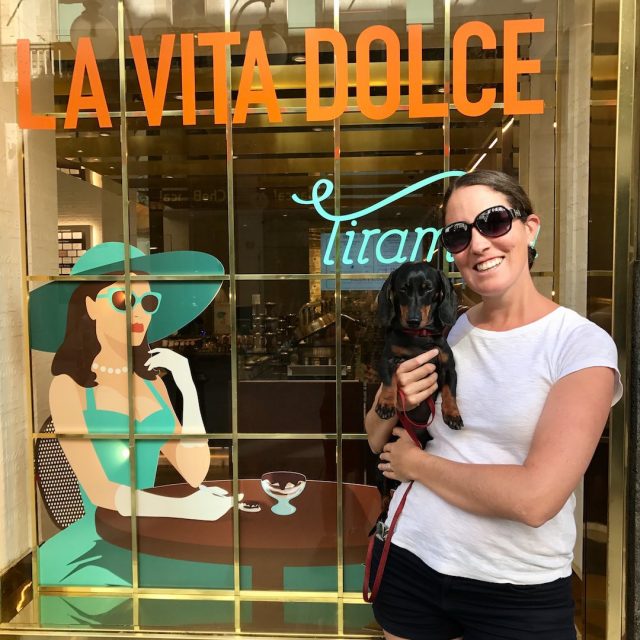
You May Also Like
About the Author

Shandos Cleaver is the founder of Travelnuity: Dog-Friendly Travel. She has travelled extensively with her Miniature Dachshund, Schnitzel, including to 33 countries across Europe, every state and territory of Australia except Tasmania, and 10 of the United States. She’s passionate about providing inspiration and information to others wanting to travel with their dogs, whether close to home or internationally.
Inspired? Pin this to your Pinterest board!
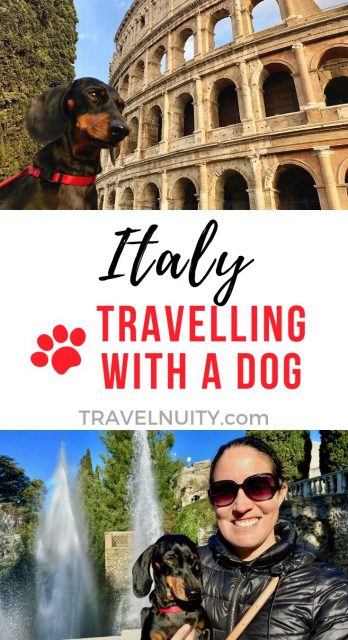

Thank you, this was very helpful! I am taking my dog to Tuscany this summer and will try to find nice activities that allow him to tag along.
Great to hear Cher, have a lovely time!
I live in Vancouver BC and go home ( Denmark) twice a year with my boy.We also go to Milan and Lugano.I was thinking of extending and going to somewhere other in Italy,where would you recommend ? I love Rome so would be 1st but Ive been there..Any others? Thanks for this blog love it Christel
Christel – Last year we visited the Dolomites region near the Austrian border and loved it. There’s plenty of hiking, or dog-friendly gondolas if you’re like us! The Lake Garda region is also very pretty and I would love to spend some more time there next time we visit Italy. Verona is a lovely small city to explore for the day too, although like all Italian cities there’s not much grass. Also, if you’re visited in the winter months, I recommend considering Cinque Terre. In summer it is far too busy to visit with a dog, but in winter it can still be beautiful when there’s a sunny day. Just get some information from your hotel or Airbnb on what restaurants are open. Enjoy!
This was very helpful! I will be traveling with my emotional support animal and service animal next year and I am worried about how this is going to work. Nice to know once I get there, I should have zero issues.
Glad to help! Your service animal should also be allowed in additional places and not be charged a fare on public transport, although I know the requirements for service animals to be recognised differ from country to country. Also note that emotional support animals aren’t usually recognised in Europe, except for on selected airline flights, but with these generous rules for all pets, that shouldn’t be an issue.
Thank you so much for all the excellent info! I go to school in Europe and have traveled all over with my medium-sized little girl; I think Scotland’s probably been the most dog-friendly, with Austria/Germany a close second… But the only place we’ve had any issues has been Belgium. My question for traveling in Italy: I traveled around Italy a couple’ve times before I had my dog and I recall there were a lot of strays or “community dogs”; these guys were very friendly with humans but seemed territorial with one another (e.g., at Pompeii… Where, for the record, I wouldn’t attempt to bring her 🙂 ). Did you encounter any strays, and if so did you have any issues, and if not do you think they’d’ve had issues with a larger, non-portable pup? Any and all advice will be much appreciated!
We came across stray dogs in southern Italy and Sicily, plus in Romania and Bulgaria. I wouldn’t be too concerned about them. They are quite timid when humans approach them or raise their voice (I think they often are hit). They wanted to play with my dog, and seemed sad when he wanted to bark (small dog syndrome), rather than angry. But always keep an eye out and i recommend keeping your own dog on a leash.
Thanks for the tip about Scotland! We also found it wonderful. And Italy is also very dog friendly, enjoy!
I was wondering how is it with dogs and museums in Italy? I have a chihuahua, and we always travel in a carrier. I would also have her in her carrier when in museum, but I don’t think they are allowed?
Love your blog, best, Mikela
Thanks Mikela! Unfortunately dogs are still generally not allowed in museums in Italy, but always check. A few museums do allow small pets to be carried or in a carrier, or small museums might be kind and bend the rules. I’ve also found this to be the case in Germany and Estonia.
Something we learned about buying dog tickets in Italy. You can not buy a stand alone dog ticket. You must buy people and dog ticket all at once.
Trenitalia Regional train- buy people and dog tickets at either kiosk or window. No advantage to buying in advance. Must buy people and fig ticket at once. Dig is 50% off.
Trenitalia High speed trains. When we purchased our discounted tickets online, then attempted to buy Barley’s tickets in Florence, it took an hour. I think there was a problem opening up a non refundable reservation to add a dog ticket. So advice is to go to train station ticket window and buy reduced price people tickets along with 50% off full price fare at same time for dog. Often, the dog fare is more than a supersaver economy fare.
ITALO
Avoid. We purchase tickets from Milan to Bologna, and read that a dog ticket was 50 Euros but couldn’t be purchased on line. When we went to Italo window to buy dog ticket, we were told you can not buy a dog ticket with a discounted or economy fare. They told me I’d have to buy a new first class ticket and then call a number to buy the €50 dog ticket. So purchased a trenitalia ticket with dig ticket for €61 two weeks before travel.
Barley – Thanks so much for letting me know about this. I’ve done this in other countries such as France (where you need to buy the extra dog ticket even for small dogs), and had assumed it would also be possible in Italy. That’s terrible to hear about the conditions with Italo. I’ve heard praise from other people for their pet service, but it is very expensive!
We are heading to Italy with our pup tonight! Did you find any particularly delicious and dog-friendly restaurants and bars in lake como?
Kim – Sorry about the late reply, I’ve been having a break over Christmas. I can’t recommend any particular places (I remember we had a delicious meal on one of the main squares, but don’t remember the name). But most restaurants and bars should allow dogs, so just take your pick and ask at the door!
Thanks very much for the information… super helpful. I’m planning travel to Italy from the US but having trouble finding the information for return from vacation from Italy with my dog. I’ve read about pet export certificate being needed. Do you have information or know how to go about obtaining this before a return flight home? Do you know if it is difficult to obtain from the ASL office? Thanks so much.
Jen, I’ve been meaning to put together some information about this from some people I know who have done it (as I haven’t done it myself). I recommend joining my FB group, Dog-Friendly Travel RTW Community and asking there. I’ll be home with my laptop also in a couple of days, so will try and source the information then. Unfortunately, from what I’ve read, it’s a confusing process!
Thank you so much for all the information provided! We are planning to move to Italy later this year and before finding an apartment in Italy we were considering renting an airbnb for a couple of months, however we do own a cat and were wondering whether this would not be a problem finding any place to stay with our cat. We do understand, that all of this information is based on a pet dog, not a cat, however would by any chance you happen to have or know any information regarding staying at airbnbs in Italy with a cat? Are hosts or owners generally more accepting towards dog pet stays and do they mind cats as pets? Thank you so much for any provided information in advance!
Monica – This isn’t an area that I’ve kept a close eye on, but I’ll try and help. There are some pet-friendly Airbnbs that only allow dogs (or small dogs), but there are plenty of other listings that don’t stipulate anything. I would contact the owners and check in advance if they allow cats. There are plenty of pet-friendly listings in most of Italy, so you shouldn’t have too much trouble, particularly if you’re looking for a longer term rental.
Hello. I’m so happy to have found this site. I will be retiring to Italy full-time next year and can’t wait to share my life there with my pups. The many lovely strays I saw in Sicily broke my heart. I’m hoping to connect with a rescue group in the Catania/Siracusa area to find homes for those precious angels once I’m living there. I will live in Tuscany, but will spend loads of time in Sicily. Any recommendations of rescue groups in Sicily would be appreciated.
Thank you,
Anna
Anna – I love your plan! Unfortunately I don’t have any details of rescue groups in Sicily, but I’m sure there are some and they will appreciate your help.
Do you have you have Instagram?
Yes, I’ve got Instagram: https://instagram.com/travelnuity
thank you so much for your blog, i am getting all kinds of grief wanting to take my Paco ( a chiweenie) and you convinced me 100% to take him. My only question is the few place ie colosseum in Rome, what did you do with Schnitzel, I ws thinking of just leaving Paco in the room and all he will do is sleep anyway
Yes, we often stayed in Airbnb apartments, and sometimes left him for a few hours (such as when we went to the colosseum), once he was used to it. We know he also just sleeps and is quiet, although given many Italians in apartments also have dogs, he wouldn’t be the only barking dog.
All so helpful, thank you. We have three small dogs (two Boston Terriers and one Shih Tzu) and we are thinking of going to Italy in October. It will be me, my husband, our two boys (12 and 14) in our campervan. Beaches that allow dogs seem scarce in summer – do you know if this would be any different in October or would the same rules apply? I’ve googled the question in so many different ways but still not found out whether the rules are for the summer or generally all year round. Any help would be appreciated. 🙂
I’m pretty sure by October dogs should be allowed on most beaches. I don’t as much experience in Italy, but this is the case with many beaches in Spain and France.
Thanks so much for this helpful info! I’m planning on taking my pup with me across Europe for a few weeks so all your posts have been great to read. Quick question- what did you feed your dog throughout the trip? My pup doesn’t really like or eat kibble/dry food. Did you feed Schnitzel regular food? Any tips or info you have on how you fed your dog throughout all your European trips would really help! Thanks!
Schnitzel was used to eating kibble at home, so he kept on eating kibble during our travels, though I switched brands to one commonly available throughout Europe (Royal Canin). It’s trickier if you feed raw or similar, and always on the move. Hope you come up with a solution!
Hi!
We are visiting Sicily next week with our kaninchen dachshund. Your article is very helpful!
At what time of the year did you visit Sicily with Schnitzel?
Did you vist Mount Etna and/or the Riserva di Vendicari at the southeastern coast?
We visited Sicily in February, so a little chilly but lots of sunshine. We went on a 4WD tour up Mt Etna and Schnitzel came along in his carrier in the car, but it was snowy up high (and very windy), so he stayed snug and warm inside.
Hello and thank you for your blog. Most helpful!
I have an 8-year-old standard poodle and am thinking of taking him with me on a 2-week trip to Italy. Did you leave your dog at the hotel for 2 -3 hours if you want to go to museums or theaters, places that do not allow dogs and you don’t want to inconvenience, other people,? Any problem with that?
Did you travel with your dog to other parts of Europe?
Thank you very much for your response in advance.
Best and safe travels!
Laura and Ollie
It largely depends on your dog and what they’re used to. We have left our dog behind in apartments in Europe, though not as often in hotels. Some hotels don’t allow this – it’s best to check in advance for their dog rules. With apartments, there’s usually other dogs living in them, so a bark or two isn’t as noticeable.
We travelled right around Europe with our dog. We are now living back in Australia. We had hoped to return to Europe with him this year, but haven’t been able to due to health issues.
This is really helpful as we will be traveling to Sicily this summer with our dog. I was wondering if a backpack carrier might be a good way to take a dog into some forbidden areas?
We also plan a layover in Munich.
It might be an option! At some places we’ve been allowed in carrying our dog by nice staff members, but we haven’t tried using a backpack.
Hello, very helpfull blog ! I am having a hard time finding out which supermarkets I can bring my dog with me in Rapallo , I am trying to find out before we go there. I have a standard smooth haired dachs ☺️
Christina – I’m not sure if you can find out in advance, unless you know someone who lives locally or who has visited. I think it depends on the owner of the supermarket.
This has been the most helpful blog ever!
I will be traveling to Italy from US and since my dog is a bigger one I will be putting him in the baggage hold. The thing is, I’m not sure what to do with the transporter after I land in Italy as I’m planning to travel all around the country by trains etc.
Should I sell/leave or store it somewhere?
I will need it when I will be boarding next plane home.. It’s a bit tricky but maybe you have any advise?
That’s a tricky one! When we flew to Europe with our dog in the hold, we ended up leaving it at a rubbish collection point, as even the ones for small dogs are huge and we weren’t needing it anytime soon. I would try and organise to store it. Perhaps is you ask someone near the airport where you fly in and out?
I dont want to be offensive, but there is something not soooo right with your blog post… I am twice per year for six weeks in italy, different parts all the time, and i never had so much trouble, entering restaurants like here in italy. i have a Mini Poodle and often have to discuss with waiters in italy about if its allowed or not to enter with a dog. in germany (where i am from and bring also my other dog, a american bulldog, to restaurants) the owner or waiters never say any word about any of my dogs. today, close to Potenza, Basilicata, in a village, i had a discussion with a waiter, he didnt wanted to allow my Poodle. Locals in the end helped me to get the situation straight. by law, in italy, dogs are allowed in restaurants. what the owner allows, is something else. your post just should get corrected. in germany, you never get complaints about your dog and there will never be signs at restaurants, that dogs are not allowed. in italy on the other hand, there can be signs, and also that without signs, a owner will reject you…
I’m really surprised to hear this! I have visited Italy with my dog multiple times and never had issues, and have also chatted to other pet parents who have visited Italy with their dogs, who have all remarked on how dog-friendly it is. I can only think of a few bakeries in Italy where I have seen no dog signs, but that’s similar to Germany where dogs are not allowed in regular bakeries, that are also the best places to get take-away coffees. I have also had my dog denied a few times at restaurants in Germany – two times at different restaurants in Trier, on a day with snow on the ground. I guess there’s always a chance of being turned away no matter where you are.
So … the beaches, on the whole only terrible ones are designated ‘dog’ beaches and even the you can find it’s only small sections.
With two Rhodesian Ridgebacks – our experience is different from a small dog. No issue with muzzle requests but moved along when watching folk displays – the dogs (who were laying down) can’t be near people.
Generally people ARE accepting of dogs but small dogs.